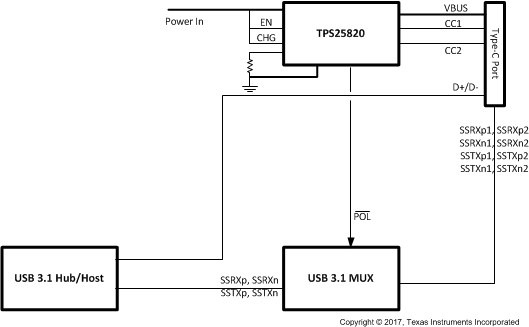JAJSE35C November 2017 – August 2019 TPS25820 , TPS25821
PRODUCTION DATA.
- 1 特長
- 2 アプリケーション
- 3 概要
- 4 改訂履歴
- 5 Pin Configuration and Functions
- 6 Specifications
- 7 Detailed Description
-
8 Application and Implementation
- 8.1 Application Information
- 8.2 Typical Applications
- 9 Power Supply Recommendations
- 10Layout
- 11デバイスおよびドキュメントのサポート
- 12メカニカル、パッケージ、および注文情報
パッケージ・オプション
メカニカル・データ(パッケージ|ピン)
- DSS|12
サーマルパッド・メカニカル・データ
- DSS|12
発注情報
8.2.3 Implementing a USB 3.1 Type-C Charging Port with the TPS25820
Figure 20 shows a conceptual implementation of USB 3.1 capable Type-C DFP, used in notebook, desktop, LCD monitor or dock application where both USB data and charging is supported. USB 2.0 data lines are connected directly to Type-C receptacle while USB 3.1 data is connected through a USB 3.1 MUX. The TPS25820 controls the USB 3.1 MUX via its POL pin. In this implementation if the USB host/hub is capable of supporting BC1.2 charging then it is possible to support both BC1.2 and Type-C charging from the same Type-C port.
 Figure 20. USB 3.1 Type-C Charging Port
Figure 20. USB 3.1 Type-C Charging Port